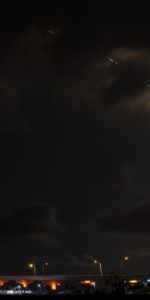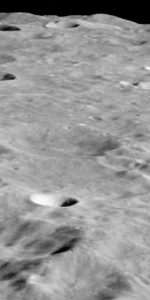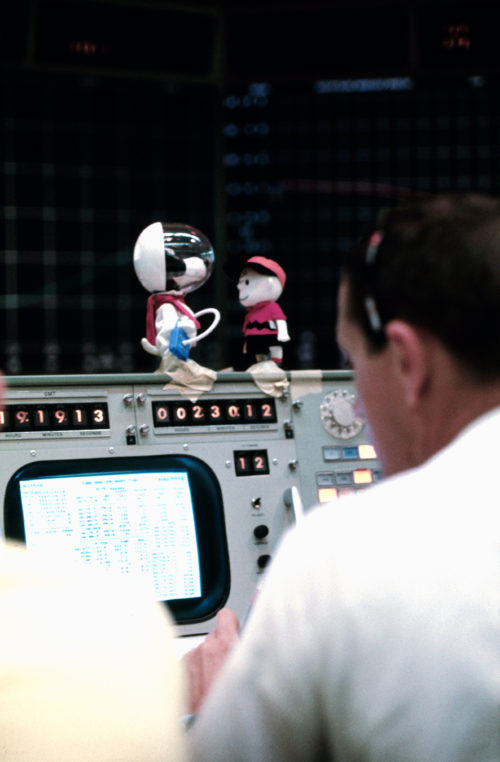
It was no understatement that Charlie Brown and Snoopy were everywhere in the days leading up to (and during) the Apollo 10 mission. Here Snoopy, clad in bubble helmet and trademark scarf, sits with Charlie on a console in Mission Control. Photo Credit: NASA
Snoopy, the little black-and-white dog from the Peanuts comic strip, was everywhere at NASA five decades ago, this month, as Apollo 10 and its three-man crew—Commander Tom Stafford, Command Module Pilot (CMP) John Young and Lunar Module Pilot (LMP) Gene Cernan—prepared for their launch to the Moon. Snoopy had become the mascot for a mission which would clear the final hurdle in accomplishing humanity’s first piloted landing on the surface of another world. As outlined in last weekend’s AmericaSpace history feature, Apollo 10 was already shaping up to be one of the most complex missions ever attempted.
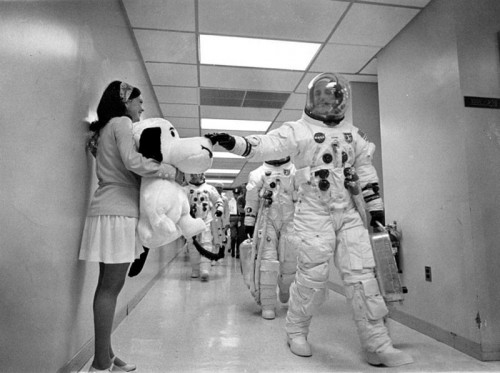
Tom Stafford pats an enormous stuffed Snoopy as he leads his crew out of the Operations & Checkout Building at Cape Kennedy for the Apollo 10 launch on 18 May 1969. Photo Credit: NASA
At Cape Kennedy in Florida, he could be seen wearing his red scarf and astronaut’s bubble helmet on sweatshirts, stickers, posters and buttons. In fact, there were some uncanny parallels with Jules Verne’s famous 1865 novel about a journey to the Moon, which also launched from Florida, also carried three men and also included a canine passenger. Yet the trials that Apollo 10 would face greatly dwarfed anything even the mind of Verne could possibly have conceived. On the morning of 18 May 1969, the risk was temporarily set aside in the excitement. Walking down the hall of the Operations and Checkout Building, Stafford spotted one of their crew secretaries, Jamie Flowers, holding an enormous stuffed Snoopy. Stafford patted it on the head, Young swiped at it and Cernan playfully tried to grab it and take it with him.
The playfulness ended when they arrived on the gantry of Pad 39B and were overwhelmed by the seriousness of what was about to happen. “The elevator door rattled closed as we rose up,” wrote Cernan in his autobiography, The Last Man on the Moon, “higher and higher and we could see clearly through the wide openings of the safety door. Every inch of the way the rocket beside us hummed and vibrated. Glass-like chunks of ice slid away as her cryogenic lifeblood…boiled and bubbled in her guts. She’s alive!” At length, the elevator stopped and technicians welcomed them to the “Twelve-Forty-Nine Express,” in light-hearted reference to their scheduled 12:49 p.m. EDT liftoff time.
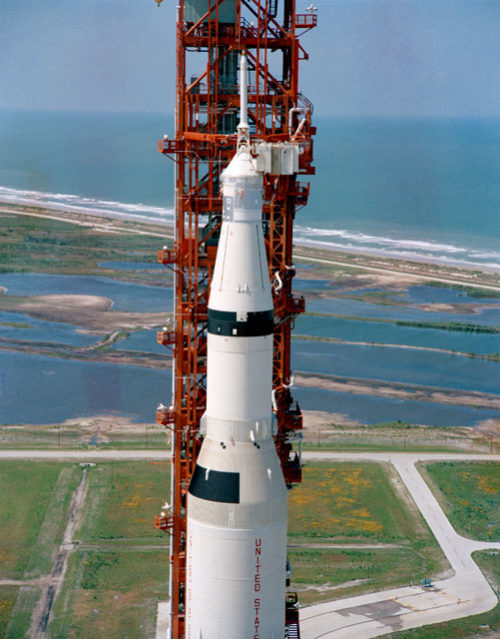
Apollo 10 was the first, and only, occasion that a Saturn V launched from Pad 39B. In fact, this mission marked the first use of the complex which is now being readied for NASA’s next super-heavylift rocket, the Space Launch System (SLS). Photo Credit: NASA
In the distance, on the beaches and roadways of the Cape, hundreds of cars and trucks and camper vans sat bumper-to-bumper. Thousands of spectators primed themselves for the event of 1969 which only one other mission could possibly surpass: the landing itself in July. It was a few minutes after 10 a.m. that Tom Stafford entered the command module, which the crew had dubbed “Charlie Brown”, and scrunched himself into the commander’s seat on the left side of the cabin. Next, Cernan assumed the right-side seat of the LMP and, lastly, came John Young in the center seat as the CMP. Pad leader Guenter Wendt—who had saved Cernan from an unfortunate episode with a deputy sheriff the day before, as outlined in last weekend’s AmericaSpace history article—wished them good luck, tapped their helmets and displayed a thumbs-up, before Charlie Brown’s hatch was closed and sealed. Stafford, Young, and Cernan would see no other human being for the next eight days.
Alone now, the men broke out their checklists and began reading data to flight controllers and implementing computer updates. Apollo 10’s stabilization and control system was checked, telemetry and radio frequencies were verified, pyrotechnics were armed, internal batteries inspected, the altimeter was updated, and Charlie Brown’s reaction control thrusters were pressurised. “No time to think,” Cernan later wrote, “just time to do.” As launch neared, external power sources were removed and Apollo 10 was transferred onto its internal fuel cells. Stafford’s hand controllers were activated and the Saturn V’s guidance system assumed control.
Nine seconds before liftoff, the astronauts felt, then heard, the fuel valves opening on the giant rocket’s S-IC first stage. Then, the five mighty F-1 engines, engorged with propellant, roared to life. Three miles (5 km) away, the launch commentator counted down the final seconds, amidst a steadily increasing din: “Ignition sequence start…five, four, three, two…all engines running…” Finally, as the Saturn V broke its shackles to Earth and ponderously rose, like Prometheus unchained, came “Launch Commit…Liftoff…We have a liftoff, at forty-nine minutes past the hour!”
Queen Fabiola of Belgium was in the VIP bleachers and instinctively grabbed the arm of her husband, King Baudouin, in surprise as the “unearthly howl” of the largest and most powerful rocket ever brought to operational status rolled over them. Even King Hussein of Jordan, who had seen many launches, flinched at the spectacle. Inside the rattling command module, Stafford, Young, and Cernan were buffeted by vibrations which rifled their way, vertically, up through the booster.
Years later, Cernan could think of only two words to describe the sensation: “Absolutely scary.” That scariness was balanced by the pure, adrenaline-fed thrill as the Saturn climbed in stately fashion toward the heavens, taking 11 seconds to clear the tower. The ride on the first stage was a smooth, guttural roar, which pitched and rolled them out over the Atlantic Ocean for the first two minutes of the mission.
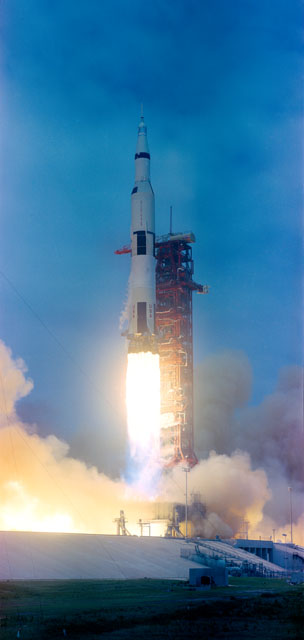
Atop a tongue of flame, and issuing an “unearthly howl”, the largest and most powerful rocket ever brought to operational status leaves Pad 39B. Said one journalist, the Saturn was “the mechanised triumph of the modern world…our pyramid of the 20th century”. Photo Credit: NASA
Next came the sharp jolt of the S-II second stage, which almost propelled them head-first into Charlie Brown’s instrument panel, and then the first worrisome signs of “pogo” arose. Pogo was an intense, low-frequency longitudinal oscillation, which rippled up through the body of the Saturn, causing it to “bounce” violently, like a giant pogo stick. “The engineers had shaved 20,000 pounds of metal” out of the S-IC, Stafford recalled, “making the booster walls more flexible and more prone to pogo. Also, there was a ground stabilization bar inside the cockpit that connected our crew couches to the rear bulkhead. It was supposed to be removed before launch, but somebody forgot. The bar magnified the pogo!”
The ignition of the Saturn’s second stage, the S-II, came with a noticeable wham, which slammed the astronauts back into their seats. “But the pogo stayed with us,” Gene Cernan wrote, “worse than ever, as another million pounds of liquid hydrogen and liquid oxygen … burned hot and hard for seven minutes and we accelerated with breathtaking speed.” This acceleration was accompanied by disturbing moans and creaks from the rocket, as its metal strained under excessive pogo forces. Stafford, Young, and Cernan could feel the effect, 20 stories beneath them, but could see nothing, for the command module’s only uncovered window was directly in front of the commander’s face.
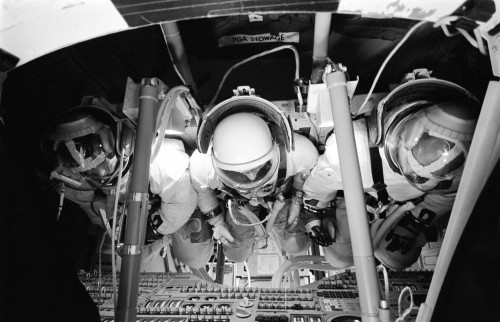
Demonstrating the smallness of the Apollo command module, this training view of the Apollo 10 crew reveals the cramped conditions of their voyage to the Moon. Photo Credit: NASA
Their momentary blindness ended when Young pushed the buttons to jettison the Saturn’s escape tower and launch shroud. These blew away with a tremendous roar, and the cabin was instantly flooded with sunlight. The violence of the event surprised Cernan, to the extent that he was momentarily convinced that Apollo 10 had been torn loose from the booster. Still, the view was electrifying, as Africa’s western shore and the startling azure blue of the Atlantic Ocean, lapping its coastline came into sight. Stafford, Young and Cernan had crossed the second-largest ocean in the world…in a mere 12 minutes.
Yet they were not quite in orbit. “We got another stomp when the third stage kicked in,” wrote Cernan. After the ignition of the S-IVB, the ride turned from an intense rocking and rolling into something he could only describe as being borne along with the grace and style of a Cadillac. Finally, when the S-IVB fell silent, Apollo 10 was in a 118-mile (190-km) “parking” orbit, around Earth, ready to commence its journey to the Moon…but with one question still unanswered: Had the pogo damaged their spacecraft?
Flight Director Glynn Lunney and his Black Team of controllers could see nothing amiss in their telemetry, but they had an uneasy feeling that something was not right. Eventually, Lunney voted with the data on his screen, which told him that nothing was wrong. When Apollo 10 picked up communications with the Carnarvon tracking station on Honeysuckle Creek in Australia, the astronauts received a “Go for TLI.”
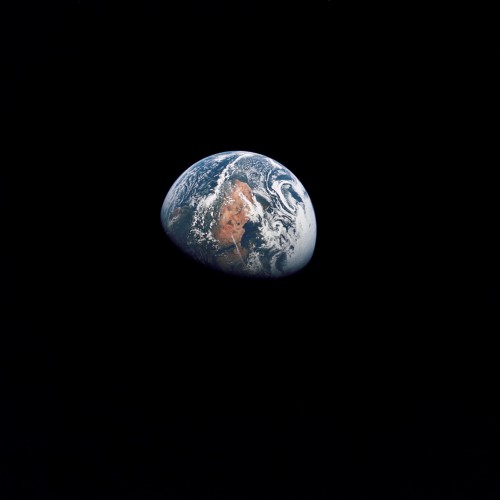
One hundred and sixty thousand kilometres from home, this electrifying view of Earth from Apollo 10 reveals many of the lands around the Mediterranean, from whence ‘Western’ civilisation arose. Photo Credit: NASA
The six-minute Trans-Lunar Injection burn of the S-IVB began at 3:19 p.m. EDT, a little more than four hours into the mission, when the third stage’s single J-2 engine came to the life for the second time that day. For three minutes of the burn, all went well. Apollo 10 accelerated briskly toward the velocity it would need to climb out of Earth’s gravitational “well” and set course for the Moon. Unfortunately, the velocity was accompanied by some disturbing vibrations through the vehicle. At their worst, these vibrations were so bad that the astronauts could hardly read their instruments. Tom Stafford kept his gloved hand tightly closed around the controller which would enable him to shut down the S-IVB and abort the mission. “We’re getting a little bit of high-frequency vibrations in the cabin,” he radioed, calmly. “Nothin’ to worry ‘bout.”
It felt like “flutter”—the aeroelastic phenomenon in which aerodynamic forces on an object, together with an aircraft’s natural vibration, produce rapid periodic motions—and Stafford was privately fearful that it would necessitate an abort. With six months left to meet President Kennedy’s goal, he simply could not bring himself to twist the abort controller. “An abort would leave us in a giant, looping orbit,” he later wrote. “There would be no visit to the Moon, no test of the lunar module, just a two-day wait for re-entry.”
For Stafford, the decision was a no-brainer: he would not call an abort. “If she’s gonna blow,” he told himself, “she’s gonna blow.” On the other side of the cabin, Cernan was thinking of the abort procedures, but also could not bring himself to execute them. Stafford repeatedly whispered, “C’mon, baby.” At length, after six minutes, the S-IVB shut down, on time. Apollo 10’s velocity was right on the money at the 23,900 mph (38,500 km/h) needed to begin the three-day voyage to the Moon. The scare illustrated a harsh truth: On the United States’ second journey beyond Earth orbit, nothing could be taken for granted and everything was still a huge unknown.
Gene Cernan summed up their feelings perfectly in his autobiography. Years of flying the most advanced aircraft on Earth, pushing them to their limits, and finding answers to pre-determined questions now counted for nothing. “Out here,” Cernan wrote, “confronting a foreign and hostile environment, where there was no horizon, no up or down, and where speed and time take on new meaning, we not only didn’t know the answers…we didn’t know the questions!”
The third part of this four-part history feature will appear next weekend.
.
.
FOLLOW AmericaSpace on Facebook and Twitter!
.
.
Missions » Apollo »



